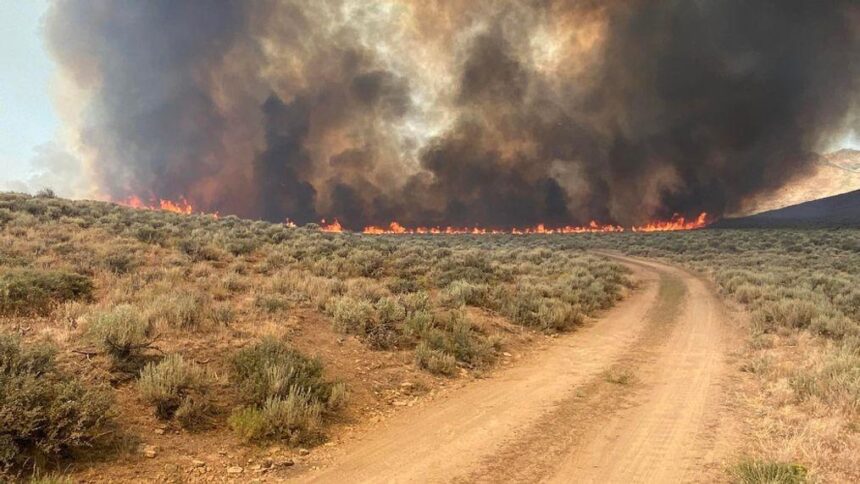Lightning strikes have ignited multiple wildfires across Elko County, with the Snowstorm Fire emerging as the state’s second-largest blaze. Firefighters are actively battling these rapidly spreading fires amid challenging conditions,as dry vegetation and strong winds fuel the flames. Authorities continue to monitor the situation closely, emphasizing the ongoing threat to communities and natural resources in the affected areas.
Lightning Storms Ignite Multiple Wildfires in Elko County Challenges in Containment and Firefighting Efforts
Multiple lightning strikes have sparked a series of wildfires throughout Elko County,overwhelming local firefighting resources and complicating containment efforts. The rapidly spreading blazes, fueled by dry conditions and high winds, have forced evacuations and prompted the deployment of additional crews from neighboring regions. One of the most significant fires, known as the Snowstorm Fire, has expanded to over 150,000 acres, ranking it as the state’s second-largest wildfire in recent history. Firefighters face rugged terrain and unpredictable weather patterns,making strategy adjustment a constant challenge.
Key challenges impacting firefighting efforts include:
- Limited access to remote fire zones due to rough landscapes
- Strong gusts continuously fanning flames and shifting fire direction
- Resource allocation across multiple simultaneous wildfire outbreaks
- Risk of thunderstorms reigniting dry tinder in affected areas
| Fire Name | Acres Burned | Containment % | Evacuations |
|---|---|---|---|
| Snowstorm Fire | 150,500 | 35% | 3,000+ |
| Thunder Ridge Fire | 45,200 | 20% | 1,200 |
| East Fork Blaze | 18,000 | 40% | 500 |
Impact of Snowstorm Fire on Local Communities and Natural Resources Emergency Response and Evacuation Procedures
The rapid expansion of the Snowstorm Fire has deeply affected the socio-economic fabric of Elko County. Several rural communities were swiftly engulfed in evacuation orders, prompting a coordinated effort between local authorities and emergency services. Residents faced immediate displacement, with many seeking refuge in designated shelters. The wildfire’s intensity also jeopardized vital infrastructure, including power lines and water supplies, complicating recovery efforts. Environmental repercussions have been severe, with large tracts of forest turned to ash, threatening wildlife habitats and disrupting local ecosystems.
Emergency responders implemented stringent measures to mitigate the blaze’s effects,prioritizing safety and resource allocation. Key components of the evacuation and response protocols included:
- Real-time dialog: Regular updates via emergency alert systems and social media channels ensured residents remained informed.
- Strategic evacuation zones: Prioritized removal of vulnerable populations including elderly, children, and those with limited mobility.
- Resource staging areas: Established to streamline firefighting logistics and support services for displaced persons.
| Evacuation Phase | Response Action | Estimated Duration |
|---|---|---|
| Alert | Issue early warnings and prepare evacuation kits | 1-2 hours |
| Evacuation | Transport residents to safe zones | 3-5 hours |
| Containment | Fire suppression and resource allocation | Ongoing |
Preventative Measures to Reduce Wildfire Risks Public Guidance on Safety and Preparedness During Lightning Seasons
As lightning events spark numerous wildfires, residents in affected regions must take proactive steps to safeguard both property and life. One critical recommendation is to create and maintain defensible space around homes by clearing dry brush, dead vegetation, and flammable materials within at least 30 feet of all structures. Additionally, homeowners are urged to install spark arresters on chimneys and maintain accessible fire extinguishers. Local authorities encourage families to develop evacuation plans, designate meeting points, and keep emergency kits stocked with essentials such as water, food, important documents, and flashlights.
During peak lightning seasons, staying informed can dramatically reduce wildfire risks. The public should:
- Monitor local weather alerts and wildfire warnings via official channels.
- Avoid outdoor activities during thunderstorms, especially in forested or brush-heavy areas.
- Report any signs of smoke or fire immediately to fire authorities.
- Practise responsible disposal of cigarette butts and avoid outdoor burning.
| Preventative Action | Recommended Practice | Benefits |
|---|---|---|
| Defensible Space Clearing | Remove dry brush 30 feet around homes | Slows fire spread, protects structure |
| Emergency Evacuation Plan | Designate safe zones and pack kits | Ensures timely, organized exit |
| Weather Monitoring | Subscribe to alerts and avoid outdoor exposure | Reduces risk of ignition from activities |
| Fire Reporting | Immediately notify authorities of smoke/fire | Speeds response, limits fire growth |
In Retrospect
As firefighters continue to battle the Snowstorm Fire, now the second-largest wildfire in Nevada’s history, authorities urge residents of Elko County and surrounding areas to remain vigilant and heed evacuation orders. The devastating impact of recent lightning strikes serves as a stark reminder of the increasing wildfire risks facing the region. Officials emphasize the importance of preparedness and ongoing support for emergency responders working tirelessly to contain the blaze and protect communities. Further updates will be provided as the situation develops.
